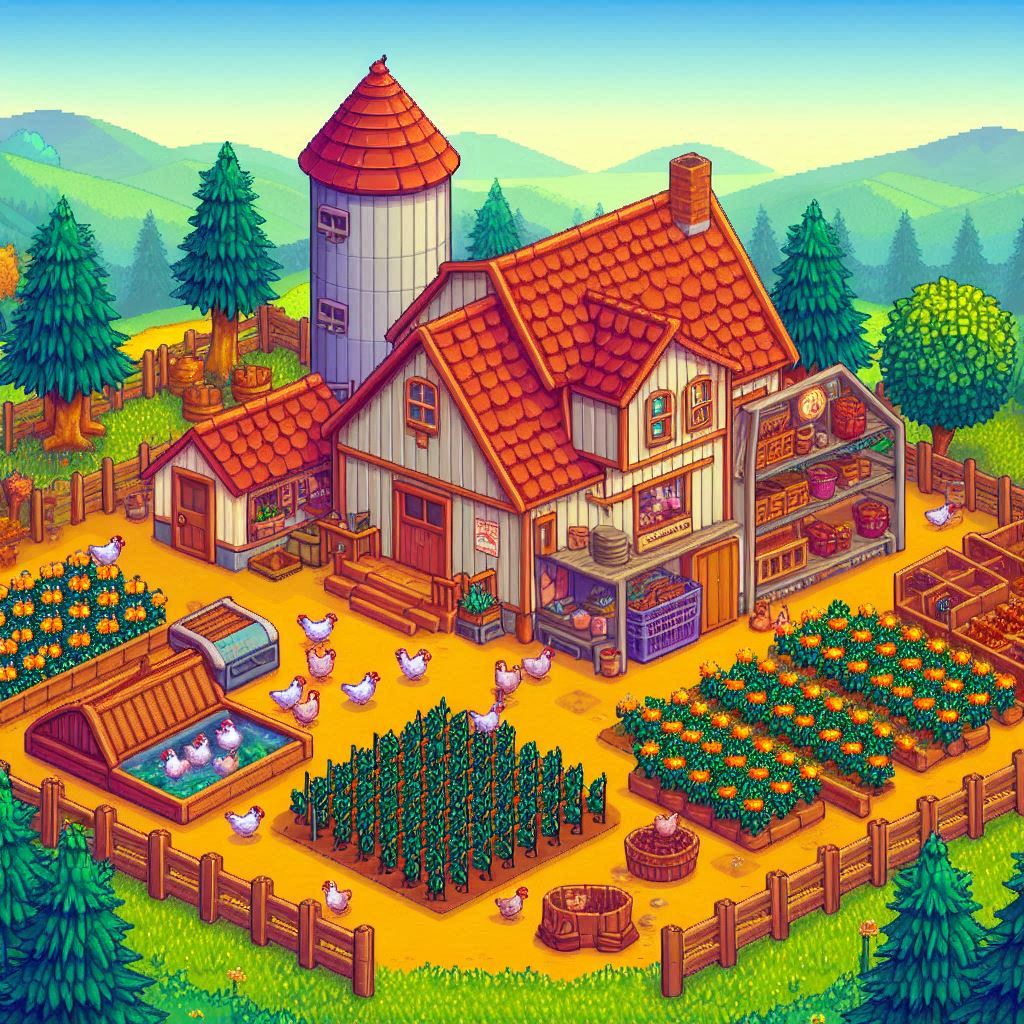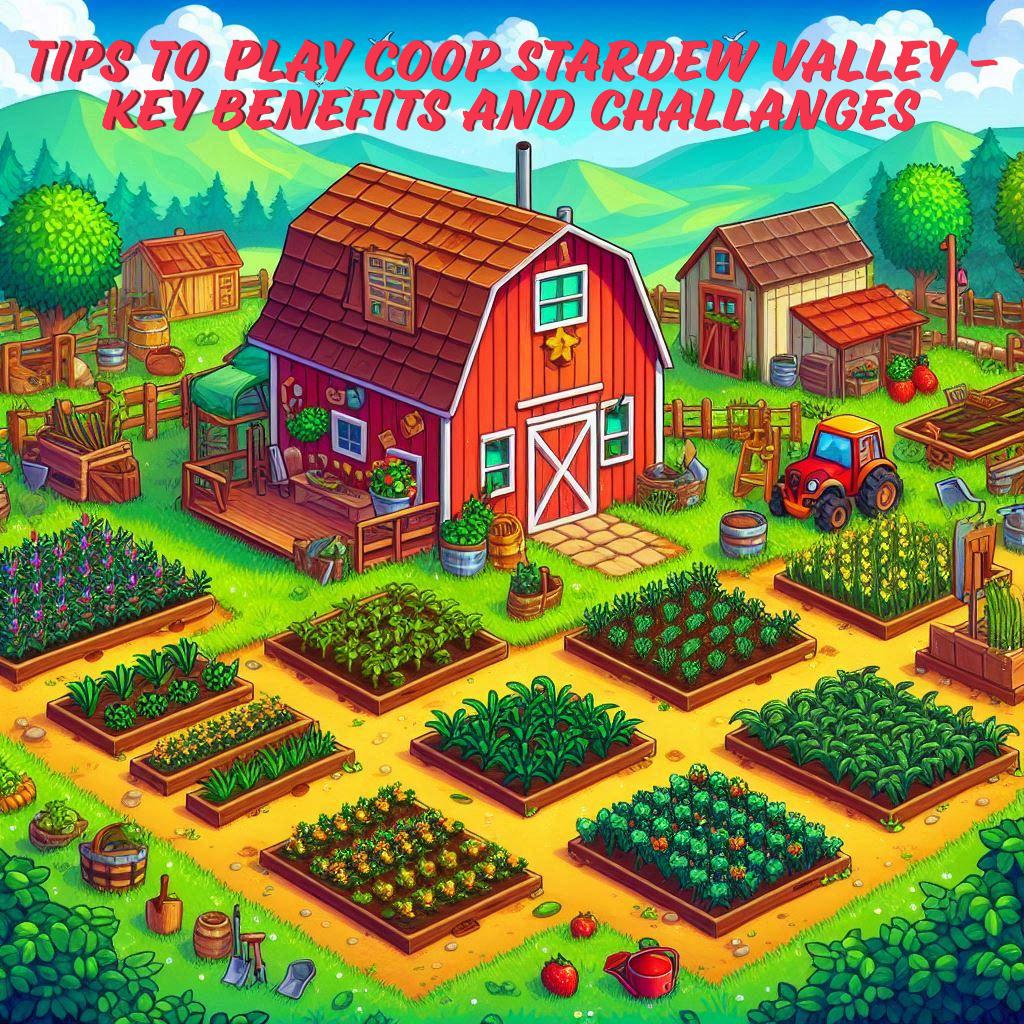Stardew Valley Coop Guide
Introduction
In “Stardew Valley,” the Coop is an essential building that allows players to raise livestock, such as chickens, ducks, and rabbits, on their farm. Adding livestock to your farm can increase your yields by providing valuable resources like eggs, feathers, and wool. In this guide, we’ll cover everything you need to know about building, upgrading, and utilizing the Coop to enhance your farming experience.
Building the Coop
How to Add a Coop to Your Farm
To build a Coop in “Stardew Valley,” follow these steps:
- Visit Robin’s Carpenter Shop: The Coop can be purchased from Robin, the carpenter in the north part of Pelican Town. Her shop is open from 9:00 AM to 5:00 PM, except on Tuesdays and Fridays.
- Gather the Necessary Materials: To build a basic Coop, you’ll need:
- 4,000g (gold)
- 300 Wood
- 100 Stone
- Choose a Location: After purchasing the Coop, you can place it anywhere on your farm. Ensure the chosen location is clear of debris and has enough space for the building.
Coop Capacity and Livestock
The basic Coop can house up to four animals, starting with chickens. To add animals to your Coop, visit Marnie’s Ranch, located south of your farm. There, you can purchase livestock like chickens for your Coop. Ensure you have enough money and space before making a purchase.
Upgrading the Coop
As you progress in the game, upgrading your Coop can unlock additional features and allow you to house more animals. Here are the upgrade tiers:
Big Coop
The first upgrade is the Big Coop, which offers several benefits:
- Cost: 10,000g, 400 Wood, and 150 Stone
- Capacity: 8 animals
- Incubator: Allows you to hatch eggs into chicks, ducks, or other poultry.
- New Animals: You can now purchase ducks from Marnie.
Deluxe Coop
The final upgrade is the Deluxe Coop:
- Cost: 20,000g, 500 Wood, and 200 Stone
- Capacity: 12 animals
- Auto-Feed System: Automatically dispenses hay for your animals, saving time.
- New Animals: Allows for the addition of rabbits.
Maximizing Coop Efficiency
To get the most out of your Coop, consider the following tips:
1. Feed and Care for Your Animals
- Feeding: Ensure your animals are well-fed daily. You can either provide hay from your silo or let them graze outside on grass (weather permitting).
- Petting: Interact with your animals daily to increase their affection level, which can lead to higher-quality products.
2. Product Collection
- Eggs: Collect eggs daily. High-affection chickens may lay large eggs, which are more valuable.
- Duck Feathers and Rabbit’s Feet: Ducks and rabbits can provide additional products that can be sold or used in recipes and crafting.
3. Incubator Use
- The incubator, available in the Big Coop and above, allows you to hatch eggs, providing a cost-effective way to expand your livestock without purchasing new animals.
4. Animal Happiness
- Housing Conditions: Ensure the Coop is clean and has adequate space. Happy animals are more productive and provide better-quality products.
- Heaters: In winter, use heaters to keep animals comfortable, as cold weather can reduce happiness and productivity.
2- How to Build the Coop in Stardew Valley
Starting the Coop Construction
Visit Robin’s Carpenter Shop
To begin building a Coop, head to Robin’s Carpenter’s Shop, which doubles as her home. The shop is located at 24 Mountain Road, north of Pelican Town. Robin is the town carpenter and the mother of Maru and Sebastian. You can visit her shop between 9:00 AM and 5:00 PM, except on Tuesdays and Fridays when the shop is closed.
Required Materials and Cost
Before Robin can start constructing the Coop, you’ll need to gather specific materials and have enough gold to cover the building cost. Here’s what you’ll need:
- 300 Wood: You can collect wood by chopping down trees and branches on your farm or around the valley.
- 100 Stone: Stone can be obtained by breaking rocks with your pickaxe in the mines or around your farm.
- 4,000 Gold Pieces: This is the fee Robin charges for building the Coop.
Make sure you have all these materials and the necessary gold before heading to the Carpenter’s Shop.
Choosing a Location
Once you’ve paid for the Coop and provided the materials, Robin will ask you to choose a location on your farm for the new building. Consider the following when selecting a spot:
- Accessibility: Ensure the location is easy to reach for daily animal care.
- Space: Make sure the area is clear of debris and obstacles.
- Expansion Plans: Keep in mind future farm expansions and other buildings you may want to add later.
After selecting the location, Robin will start construction, which will take three in-game days to complete.
Standard Coop Features and Perks
A standard Coop in “Stardew Valley” comes with several perks that make it a valuable addition to your farm:
- Maximum Livestock Capacity: The standard Coop can house up to four animals, starting with chickens.
- Livestock: Initially, you can only keep chickens. As you upgrade the Coop, you’ll be able to house other animals like ducks and rabbits.
- Features:
- Hay Hopper: This feature allows you to distribute hay to your animals. Hay can be obtained by harvesting grass with a scythe if you have a silo.
- Feeding Bench: This is where you place the hay for your animals to eat.
3 – How to Play Multiplayer in Stardew Valley
Playing “Stardew Valley” with friends can greatly enhance the farming experience, as you work together to grow crops, raise animals, and explore the game’s rich world. The multiplayer mode allows up to four players to join a single farm, collaborating on tasks and enjoying the game’s activities together. Here’s a comprehensive guide on setting up and playing multiplayer in “Stardew Valley,” available on PC, Nintendo Switch, Xbox One, and PS4.
Setting Up Multiplayer
1. Starting a Multiplayer Game
To begin a multiplayer game, you need to decide whether you want to host a farm or join a friend’s farm:
- Host a Farm: From the main menu, select “Co-op” and then choose to host a new farm or load one of your existing farms. When hosting a new farm, you can customize your farm’s layout and other settings.
- Join a Friend’s Farm: If you want to join a friend’s farm, select “Co-op” and then “Join” to see a list of available farms. You can join a friend’s farm by selecting their farm from the list.
2. Inviting Friends
No server setup is required for multiplayer. You can invite friends directly through the platform you’re using (such as Steam, Xbox Live, or PlayStation Network). The host can invite friends by sending an invite link or inviting them through the platform’s friend list.
3. Setting Up Farmhand Cabins
If you’re hosting, you’ll need to set up cabins for your friends, known as “farmhands.” You can build cabins by visiting Robin at the Carpenter’s Shop and selecting the “Build” option. Each cabin allows one friend to join your farm.
4. Adjusting the Game Economy
When starting a multiplayer game, you can adjust the game’s economy to increase or decrease the difficulty. For a more challenging experience, you can set items to sell for less, making it harder to accumulate wealth. This setting can be changed to suit your group’s preferences.
Playing Split-Screen Co-Op
For those who prefer local multiplayer, “Stardew Valley” also supports split-screen co-op:
- Create or Load a Save: Start by creating a new farm or loading an existing save.
- Build Cabins: Just like online multiplayer, you need to build a cabin for each additional player.
- Connect Controllers: After setting up the cabins, connect the necessary controllers to your computer or console. On a computer, the keyboard is reserved for the first player, so additional players will need controllers.
- Start Local Co-op: Open the in-game menu, go to the “Options” tab, and scroll to the “Multiplayer” section. Select “Start Local Co-op” and have each player press the start button on their controller to join the game.
Multiplayer Features and Limitations
Farmhands’ Capabilities
In multiplayer, farmhands (guest players) can do almost everything the host can, including:
- Farming and harvesting crops
- Taking care of animals
- Mining, fishing, and foraging
- Participating in festivals and events
However, certain actions, like deciding when to end the day and manage game options, are reserved for the host.
Known Issues and Limitations
- Cross-Platform Play: Currently, “Stardew Valley” does not support cross-platform multiplayer. Players must be on the same platform to play together. The only exception is between PC, Mac, and Linux players.
- Switch Specific Issues: Some known issues may occur on the Nintendo Switch version, such as connectivity problems or occasional crashes. Make sure to keep the game updated to the latest version to minimize these issues.
4 – How to Enable Local Co-Op in Stardew Valley
“Stardew Valley” offers a delightful local co-op mode that allows you to play with friends on the same screen. This feature is perfect for those who want to share the farming experience in person. Local co-op supports up to four players, where each player can manage their own character and contribute to the farm. Here’s a step-by-step guide to setting up local co-op in “Stardew Valley.”
Enabling Local Co-Op
1. Select the Co-Op Option
Start by launching “Stardew Valley” and navigating to the main menu. From there, select the “Co-Op” option. This will bring up a menu with different multiplayer options.
2. Choose Split Screen
After selecting “Co-Op,” choose the “Split Screen” option. This mode is designed for local multiplayer, allowing multiple players to join the game on the same device.
3. Create a New Save
If you don’t already have a save file set up for local co-op, you’ll need to create a new one. During this process, you’ll be prompted to customize your character and farm.
4. Increase the Number of Cabins
In the Character Customization menu, look to the top-left corner, where you’ll find an option to increase the number of cabins. These cabins are essential for additional players, as each cabin represents a home for one player. You can start the game with up to three additional cabins, accommodating four players in total.
5. Confirm and Host the Game
Once you’ve set up the cabins and customized your characters, click “OK” to confirm your settings and host the multiplayer game. The game will start with the host player on the farm.
6. Join the Game with Other Players
To have other players join, they need to connect their controllers to the device you’re playing on. On consoles, ensure that each controller is properly connected and recognized by the system.
To join the game, other players should press the Menu button twice on their controllers. This will spawn their characters on the farm, and they can begin playing alongside the host.
Adding Cabins Mid-Game
If you didn’t initially set up enough cabins for all players, or if you want to add more players later, you can build additional cabins in the game. To do this:
- Visit Robin’s Carpenter Shop: Head to Robin’s shop, located north of Pelican Town.
- Request Additional Cabins: Speak to Robin and select the option to build cabins. Each cabin will cost 100g, and you’ll need to select a location on your farm for the new cabin.
5 – How to Disable Local Co-Op in Stardew Valley
“Stardew Valley” offers a local co-op mode that allows multiple players to share the farming experience on the same screen. However, there may come a time when you want to disable local co-op, whether it’s to manage the game differently or revert to single-player mode. Here’s how to do it:
Exiting Local Co-Op
1. Exiting Multiplayer Mode
To disable local co-op, other players (farmhands) need to exit the game. This can be done easily from the in-game menu:
- Press the Pause Button: Each player should press the Pause button on their controller to bring up the in-game menu.
- Select “Exit Game”: Navigate to the “Exit Game” option and select it. This will remove the player from the game session.
Exiting this way will not affect the progress of other players. The host can continue playing, and the farm’s progress will be saved as usual.
2. Host Leaving the Game
If the host player decides to exit the game, it will automatically disconnect all other players from the session. To do this:
- Press the Pause Button: As the host, press the Pause button.
- Select “Exit Game”: Choose the “Exit Game” option. This action will save the current state of the game and disconnect all other players.
Remember, only the host has the ability to save the game. If other players exit, the game will not be saved for them unless the host also exits and saves.
Removing Additional Players
Another way to disable local co-op is by removing the option for additional players to join the game. This can be done by demolishing the extra cabins that other players use to join the game.
1. Visit Robin’s Carpenter Shop
To remove the cabins, visit Robin at the Carpenter’s Shop. The shop is located north of Pelican Town and is open most days from 9:00 AM to 5:00 PM.
2. Choose the “Demolish Buildings” Option
Speak to Robin and select the “Demolish Buildings” option. This will allow you to choose which buildings on your farm you wish to remove.
3. Demolish Extra Cabins
Select the cabins you want to demolish. Confirm your choice, and Robin will remove the cabins from your farm. This action will prevent other players from joining your game in the future, as there will be no cabins available for them to use.
Conclusion
Disabling local co-op in “Stardew Valley” is straightforward and can be done either by having players exit the game or by removing extra cabins. Whether you’re looking to revert to single-player gameplay or simply want to manage your farm differently, these methods will help you control the multiplayer experience. Keep in mind that removing players or cabins will not delete your progress, and you can always re-enable co-op by adding cabins again in the future. Happy farming.




